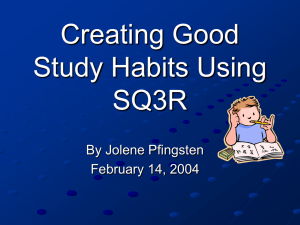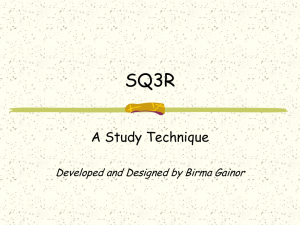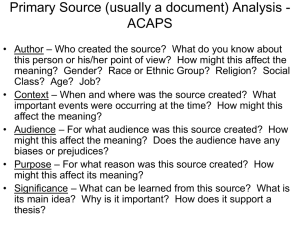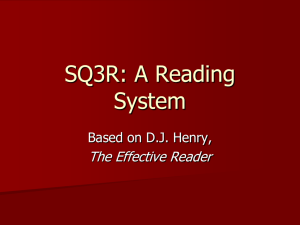My thoughts on Mind Maps & SQ3R as Classroom Tools (TESOL school assignment)
advertisement
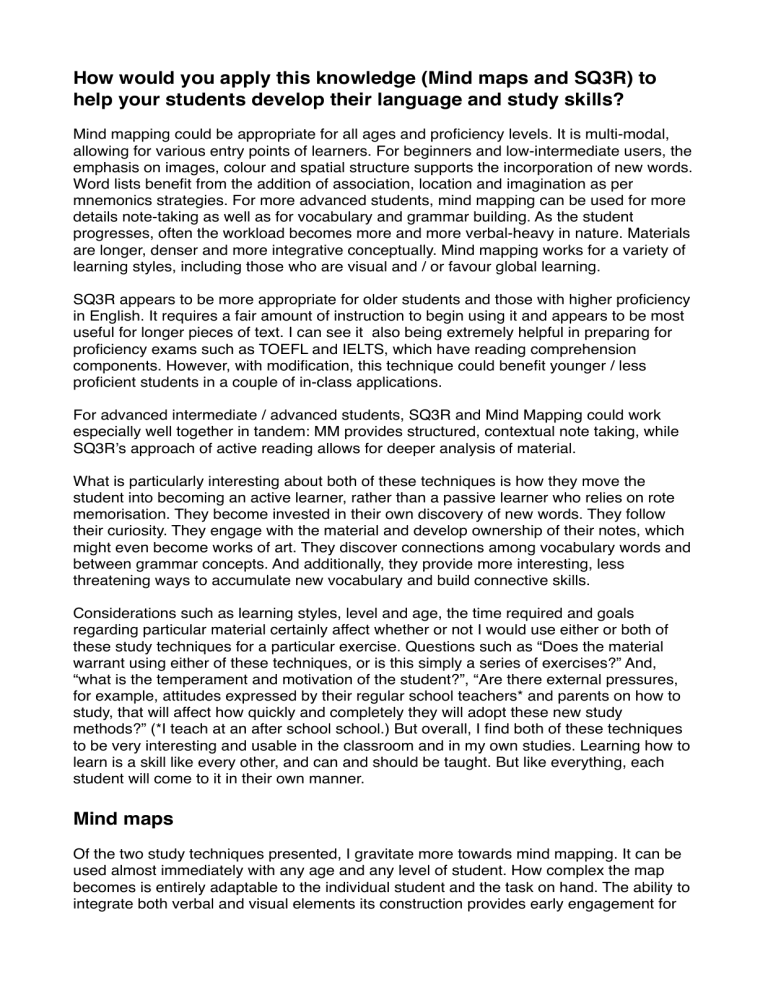
How would you apply this knowledge (Mind maps and SQ3R) to help your students develop their language and study skills? Mind mapping could be appropriate for all ages and proficiency levels. It is multi-modal, allowing for various entry points of learners. For beginners and low-intermediate users, the emphasis on images, colour and spatial structure supports the incorporation of new words. Word lists benefit from the addition of association, location and imagination as per mnemonics strategies. For more advanced students, mind mapping can be used for more details note-taking as well as for vocabulary and grammar building. As the student progresses, often the workload becomes more and more verbal-heavy in nature. Materials are longer, denser and more integrative conceptually. Mind mapping works for a variety of learning styles, including those who are visual and / or favour global learning. SQ3R appears to be more appropriate for older students and those with higher proficiency in English. It requires a fair amount of instruction to begin using it and appears to be most useful for longer pieces of text. I can see it also being extremely helpful in preparing for proficiency exams such as TOEFL and IELTS, which have reading comprehension components. However, with modification, this technique could benefit younger / less proficient students in a couple of in-class applications. For advanced intermediate / advanced students, SQ3R and Mind Mapping could work especially well together in tandem: MM provides structured, contextual note taking, while SQ3R’s approach of active reading allows for deeper analysis of material. What is particularly interesting about both of these techniques is how they move the student into becoming an active learner, rather than a passive learner who relies on rote memorisation. They become invested in their own discovery of new words. They follow their curiosity. They engage with the material and develop ownership of their notes, which might even become works of art. They discover connections among vocabulary words and between grammar concepts. And additionally, they provide more interesting, less threatening ways to accumulate new vocabulary and build connective skills. Considerations such as learning styles, level and age, the time required and goals regarding particular material certainly affect whether or not I would use either or both of these study techniques for a particular exercise. Questions such as “Does the material warrant using either of these techniques, or is this simply a series of exercises?” And, “what is the temperament and motivation of the student?”, “Are there external pressures, for example, attitudes expressed by their regular school teachers* and parents on how to study, that will affect how quickly and completely they will adopt these new study methods?” (*I teach at an after school school.) But overall, I find both of these techniques to be very interesting and usable in the classroom and in my own studies. Learning how to learn is a skill like every other, and can and should be taught. But like everything, each student will come to it in their own manner. Mind maps Of the two study techniques presented, I gravitate more towards mind mapping. It can be used almost immediately with any age and any level of student. How complex the map becomes is entirely adaptable to the individual student and the task on hand. The ability to integrate both verbal and visual elements its construction provides early engagement for students with a wide variety of language skill levels and learning styles. The act of making a mind map is very simple to demonstrate. It does not require a lot of explanation beyond simply modelling it. As the age and level of the students increase, more complex explanations can be included about how to use mind maps to reveal deeper structure and context within the material. Applications: Mind maps + younger / beginner ESL learners in the classroom Inspired by my readings for this assignment, this past week I began integrating mind maps into my lessons at my school, using a simple map as a warm up exercise at the beginning of several of my classes. Inside a bubble I wrote a topic word, one that has been recently taught such as “food” or “clothes”, and invited the student(s) up to the board to brainstorm as many words as they could related to it. If they were stuck, I gave them prompts including making silly drawings and pointing at objects. We then read the words out loud and added more as they came up. As we read them, I gently corrected any spelling mistakes. They seemed to like this warm up because, well… writing on the board is fun! Plus, presented as a game, it was a low stakes activity. Also, the non-list formatting removes the air of “memorization” from the task. I am curious to see how this will enhance their integration of these new words, along with their spelling, into their working memories and how it deepens their connections between words. In the future I would like to further incorporate mind mapping by showing my students how to use it to connect word families together, which they can then try in their own notebooks. We could start with the centre topic of, for example, “weekend activities”. I would prompt them to name subcategories such as “at home”, “around the city”, “ out in nature”, “play time”, “travel”. Then, by relating this activity to the map we created on the board during the warm up, ask them to find vocabulary for each of the subcategories. I would then encourage them to identify connections between words, such as those words related to eating, those that you do with friends or with family, etc. They could also create a spoke that explores the grammar rules related to this set of words… for example, present simple vs present continuous or words related to frequency. Alternatively, this new bubble could become its own map based on the grammar topic that week. Once they have seen mind maps with more than one level modelled in class and understand the process of making them, I will ask them to create their own maps at home based on whatever the current topic is we are studying. I will ask them to find vocabulary in the materials from class as well as to brainstorm more from their own experience. I will ask them to draw or collect pictures both to demonstrate each of the words, as well as to create images for English words that they don’t know yet. Applications: Mind maps + older / more advanced ESL learners in the classroom As I become more comfortable working with this technique, I would like to introduce mind maps to my intermediate and advanced students as a note taking technique and for vocabulary building. Because we will better be able to talk through not only the process but also the function of the maps, I hope to encourage these students to use mind mapping to explore the way their brains prefer to structure and connect information. This customised approach to studying could result in students being better able to integrate and faster access new elements of the language and its usage as they come across it. Personal applications of Mind maps While researching this assignment, I realised I have already been using a form of mind mapping in my other work as a songwriter, generating ideas through the associative properties of the technique. In this creative capacity and in the arena of teaching, mind maps could be very helpful when I am developing lesson plans. They could help me to identify ways to structure the lesson: expanding on what is and isn’t within the scope of the topic; identifying strategies to explain it (games, reading exercises, repetition, audio / visual aids); noting resources required; outlining teaching steps; finding real life relevancy; as well as addressing different learning styles when presenting the material. I have also already begun integrating mind maps into my Ontesol studying habits. In fact, for this particular assignment I generated two mind maps - one for taking notes on the various articles I read in preparation and a second to generate ideas for this essay (attached.) I am also trying out mind maps in my own German studies to see if it helps me with retention of new vocabulary and grammar points. Traditional word lists don’t really work for me, and I am curious if I will have better luck recalling things I learn using this approach. SQ3R I am less familiar with this technique and so the following thoughts are more imagining and less real world observations. After reading the article in our course work and doing additional research about it, I can see how SQ3R could be an effective technique. Perhaps one of the key benefits of this technique is that, like mind mapping, SQ3R slows the student down and at the same time engages their brain in active reading, listening and learning. The Survey stage creates an overall context within which new ideas can be placed. The Question stage prepares the brain for active reading and full engagement with the material. The 3 R stages: Reading, Recalling and Reviewing bring the material back to the mind’s forefront several times, and in a variety of modes from reading to discussion, which lets the information really soak into our memories. In order to use SQ3R successfully as an independent study tool, the student will need enough facility in English to understand what the various steps are and how to implement them. For that reason, SQ3R appears to be more relevant for older, more proficient students. It also requires the ability to identify context across the material and to be able to formulate questions from the text. My impression of SQ3R based on some of the articles I have read, is that it seems to be better suited for denser texts such as textbooks and research materials. As a study technique, it significantly improves comprehension and fact retention when dealing with longer more complex material. I want to highlight one interesting discovery that I found while exploring this technique, and something that can be implemented independently of all the other stages: the importance of the question formulation stage. Its effectiveness seems to be that by asking questions in advance of approaching new material, the student’s mind becomes prepared and has a place to put new information that they discovers. Even if the questions are only a reforming of, for example, the titles of the chapter and subheadings, they have the effect of engaging the mind much more actively than by simply reading the them as statements. Applications: SQ3R + younger / beginner ESL learners in the classroom However, by making some adaptations to the SQ3R technique I can see a couple of applications that could work well in my classrooms of primarily younger and/or less advanced learners. Even though most of the students that I teach are quite limited in their command of English and as such are faced with at most three paragraphs of English at a time, they can learn to mine for context the title, the images on the page as well as any side bars that highlight important grammar or vocabulary. This Survey stage could also include the pre-teaching of any new vocabulary and identifying names and places that will come up in the text. During the Question stage, students can start with questions that are often provided in the course book. They can also learn to form their own questions, such as “what is this story about?”, “who are the people in the story?”, “where does this story take place?” and “what does this word mean?”. A second application of SQ3R I can see in my classroom applies to listening exercises. Before playing an audio piece to my student, I would tell them what the topic is. I would then ask them to guess what the audio might be about and what kind of words might come up in it. I would encourage them to formulate questions such as “who are the speakers?”, “how do they know each other?”, “what are they talking about?” Listening would replacing the reading stage. I would ask comprehension questions as the recall stage. If there is a written script, the student would follow along while listening again during the review stage, Applications: SQ3R + older / more advanced ESL learners in the classroom For my (one or two) more advanced students, the context and questions generated during the Survey and Question stages may be enough to help them guess meanings of unfamiliar words when encountered in the reading stage. The students can use their previous knowledge of similar words to try to learn their meaning within the context of the text. If they can’t figure it out in this stage, they can use the reading stage to highlight these unfamiliar words as well as note any important concepts that come up. If the student is still unsure of the meaning of a word after reading the text, they can either look them up in a dictionary or bring them to class so that we can discuss them together while recalling and reviewing. By preconditioning themselves with context, questions and pre-identifying unknown words, when they do the actual deep reading part, they are more likely to get a better understanding out of the content. Additionally, by recalling the text through discussion and explanation, such as a short oral report, they will have the opportunity to use the new vocabulary as well as solidify other vocabulary that they already know, bringing these words into more active use. Personal applications of SQ3R While I haven’t yet explored the full potential of SQ3R in my studies, I have begun surveying and asking questions when approaching my reading of articles in this course. I had a look forward to those talking about learning styles vs multiple intelligences. By slowing down, surveying and asking questions about what I was reading, I have already noticed that I was able to take in more information than I usually do when confronted with texts that are filled with names and citations. While I’m sure there is an application for SQ3R in the grammar module, I imagine that it will become even more helpful in the third section, as I begin to engage with longer, more dense texts about teaching theory. I am quite sure this technique in combination with mind mapping will be helpful for me in my tendency to gloss over facts such as numbers and names of people and places. I am excited to think that by re-forming the reading experience as a series of questions to consider, and with the next step of synthesising and explaining the information that I will have more success digesting the materials in this course.
